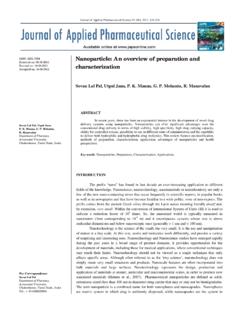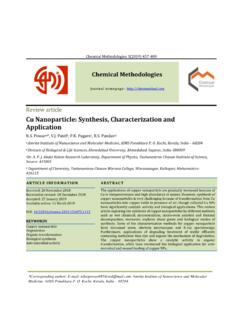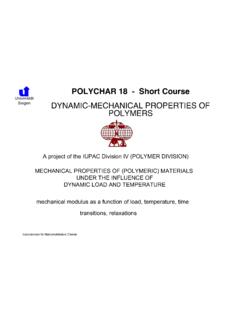Transcription of Hydrogels: Introduction, Preparation, Characterization and ...
1 Human Journals Review Article October 2015 Vol.:1, Issue:1 All rights are reserved by Shivani P. Shetye et al. Hydrogels: Introduction, Preparation, Characterization and Applications Keywords: hydrogels, swelling, mechanical, biocompatible, preparation, applications, sensors, contact lenses ABSTRACT Hydrogels are three-dimensional, hydrophilic, polymeric networks capable of absorbing large amounts of water or biological fluids. Due to their high water content, porosity and soft consistency, they closely simulate natural living tissue, more so than any other class of synthetic biomaterials.
2 Furthermore, hydrogels can be formulated in a variety of physical forms, including slabs, microparticles, nanoparticles, coatings, and films. As a result, hydrogels are commonly used in clinical practice and medicine for a wide range of applications, including Tissue engineering and Regenerative medicine, Diagnostics, Cellular immobilization, separation of biomolecules or cells, and barrier materials to regulate biological adhesions. Hydrogels are also relatively deformable and can conform to the shape of the surface to which they are applied. In the latter context, the mucoadhesive or bioadhesive properties of some hydrogels can be advantageous in immobilizing them at the site of application or in applying them on surfaces that are not horizontal.
3 They have started to create a niche in several fields of medicine like in specific site drug delivery, tissue reconstruction and tissue engineering and even as biosensors. In this review article an attempt has been made to explain the properties of hydrogels, their methods of preparation and its applications. Shivani P. Shetye*, Dr. Ajeet Godbole, Dr. Shilpa Bhilegaokar, Pankaj Gajare Department of Pharmaceutics, Ponda Education Society s Rajaram and Tarabai Bandekar College of Pharmacy, Farmagudi, Ponda, Goa, India. Submission: 22 September 2015 Accepted: 29 September 2015 Published: 15 October 2015 Citation: Shivani P.
4 Shetye et al. , 2015; Vol. 1 (1): 47-71. 48 INTRODUCTION Hydrogels are three-dimensional, hydrophilic, polymeric networks capable of absorbing large amounts ofwater or biological fluids. Due to their high water content, porosity and soft consistency, they closely simulate natural living tissue, more than any other class of synthetic biomaterials. Hydrogels may be chemically stable or they may degrade and eventually disintegrate and dissolve [1]. They are prepared from materials such as gelatin, polysaccharides, cross-linked polyacrylamide polymers, polyelectrolyte complexes, and polymers or copolymers derived from methacrylate esters.
5 They are insoluble in water and are available in dry or hydrated sheets or as a hydrated gel in drug delivery systems designed for single use [11]. Furthermore, hydrogels can be formulated in a variety of physical forms, including slabs, microparticles, nanoparticles, coatings, and films. As a result, hydrogels are commonly used in clinical practice and medicine with a wide range of applications, including Tissue Engineering and Regenerative Medicine, Diagnostics, Cellular immobilization, Separation of biomolecules or cells, and barrier materials to regulate biological adhesions [3]. These unique physical properties of hydrogels have stimulated particular interest in their use in drug delivery applications.
6 Their highly porous structure can easily be tuned by controlling the density of cross-links in the gel matrix and the affinity of the hydrogels for the aqueous environment in which they are swollen [3]. Their porosity also permits loading of drugs into the gel matrix and subsequent drug release at a rate dependent on the diffusion coefficient of a small molecule or a macromolecule through the gel network [3]. Since the polymer cannot dissolve due to the covalent crosslinks, water uptakes far in excess of those achievable with hydrophilic linear polymers can be obtained [14]. Citation: Shivani P. Shetye et al. , 2015; Vol.
7 1 (1): 47-71. 49 Indeed, the benefits of hydrogels for drug delivery may be largely pharmacokinetic specifically that a depot formulation is created from which drugs elute slowly, maintaining a high local concentration of drug in the surrounding tissues over an extended period of time, although they can also be used for systemic delivery [3]. Hydrogels are also generally highly biocompatible, which may be attributed to the high water content of hydrogels. Biodegradability or dissolution in case of hydrogels may be brought about by enzymatic, hydrolytic, or environmental ( pH, temperature, or electric field) pathways; however, degradation is not always desirable depending on the time frame and location of the drug delivery device [3].
8 Hydrogels are relatively deformable and can conform to the shape of the surface onto which they are applied. In the latter context, the mucoadhesive or bioadhesive properties of some hydrogels can be advantageous by keeping them immobilized at the site of application or in applying them on surfaces that are not horizontal. However the amount and homogeneity of drug loading into hydrogels may be limited, particularly in the case of hydrophobic high water content and large pore sizes of most hydrogels often result in relatively rapid drug release, over a period of few hours to a few days. Ease of application can also be problematic; although some hydrogels are sufficiently deformable to be injectable, many are not, necessitating surgical implantation [3].
9 Above problems restrict the practical use of hydrogel-based drug delivery systems in the clinical practice [3]. Classification of hydrogel products The hydrogels can be broadly classified on different bases as detailed below: 1) Classification based on source Hydrogels can be classified into two groups based on their natural or synthetic origins [5]. Citation: Shivani P. Shetye et al. , 2015; Vol. 1 (1): 47-71. 50 2) Classification according to polymeric composition The method of preparation leads to formations of some important classes of hydrogels. These can be exemplified by the following: (a) Homopolymeric hydrogels are referred to polymer network derived from a single species of a monomer, which is a basic structural unit comprising of any polymer network.
10 Homopolymers may have cross-linked skeletal structure depending on the nature of the monomer and polymerization technique [5]. (b) Copolymeric hydrogels are comprised of two or more different monomer species with at least one hydrophilic component, arranged in a random, block or alternating configuration along the chain of the polymer network [5]. (c) Multipolymer interpenetrating polymeric hydrogel (IPN), an important class of hydrogels, is made of two independent cross-linked synthetic and/or natural polymer components, contained in a network form. In semi-IPN hydrogel, one component is a cross-linked polymer and other component is a non-cross-linked polymer [5].






